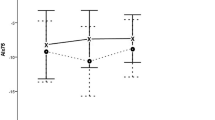Summary
Brachial arterial pressure, oesophageal pressure, and knee joint angle were monitored in eight untrained young men as they performed bilateral leg-press actions (simultaneous hip and knee extension and ankle plantarflexion) against resistance. Single maximal leg-press actions on an isokinetic device evoked mean peak arterial (systolic/diastolic) pressures of 35.4/26.2 and 34.0/23.4 kPa at lever arm velocities of 0.262 and 1.31 rad·s−1, respectively. The corresponding oesophageal pressures were 13.2 and 10.4 kPa, respectively. Although the peak force was 30% greater, and duration of the action 3–4 times longer at 0.262 than 1.31 rad·s−1, the arterial and oesophageal pressure responses did not differ. On a weight-lifting machine, a set of repetitions [mean (SEM): 11 (3)] to failure at 80–90% one repetition maximum evoked peak arterial pressures of 45.5/32.8 kPa; the corresponding oesophageal pressure was 15.7 kPa. The peak systolic and diastolic pressures observed during weight-lifting were significantly (P < 0.05) higher than during isokinetic actions at both velocities, whereas oesophageal pressure was more elevated only in relation to isokinetic actions at the higher velocity. These data indicate that resisted leg-press actions cause extreme elevations in arterial blood pressure. The degree of voluntary effort is the major determinant of the blood pressure response, rather than the resistance mode or the type (concentric, eccentric, isometric) of muscle action. Repetitive resistance exercise (e.g. a set of repetitions to failure in weight-lifting) tends to produce greater pressure elevations than isolated, single maximal effort actions.
Similar content being viewed by others
References
Fleck SJ, Dean LS (1987) Resistance-training experience and pressor response during resistance exercise. J Appl Physiol 63:116–120
Freedson P, Chang B, Katch F, Kroll W, Rippe J, Alpert J, Byrnes W (1984) Intra-arterial blood pressure during free weight and hydraulic resistive exercise. Med Sci Sports Exerc 16:131
Haslam DRS, MacCartney N, McKelvie RS, MacDougall JD (1988) Direct measurements of arterial blood pressure during formal weightlifting in cardiac patients. J Cardiopul Rehabil 8:213–225
Komi PV (1992) Stretch-shortening cycle. In: Komi PV (ed) Strength and power in sport. Blackwell, London. pp 169–179
MacDougall JD, Tuxen D, Sale DG, Moroz JR, Sutton JR (1985) Arterial blood pressure response to heavy resistance exercise. J Appl Physiol 58:785–790
MacDougall JD, McKelvie RS, Moroz DE, Sale DG, McCartney N, Buick F (1992) Factors affecting blood pressure during heavy weightlifting and static contractions. J Appl Physiol 73:1590–1597
Mitchell JH (1990) Neural control of the circulation during exercise. Med Sci Sports Exerc 22:141–154
Vandervoort AA, Sale DG, Moroz J (1984) Comparison of motor unit activation during unilateral and bilateral leg extension. J Appl Physiol: Respirat Environ Exercise Physiol 56:46–51
Author information
Authors and Affiliations
Rights and permissions
About this article
Cite this article
Sale, D.G., Moroz, D.E., McKelvie, R.S. et al. Comparison of blood pressure response to isokinetic and weight-lifting exercise. Europ. J. Appl. Physiol. 67, 115–120 (1993). https://doi.org/10.1007/BF00376653
Accepted:
Issue Date:
DOI: https://doi.org/10.1007/BF00376653




